Dropshipping Checklist – 11 Things To Do Before Starting
Looking for an ultimate (but, easy to execute) dropshipping checklist? Prepare to “copy” my methodology.
It is no secret that each entrepreneur in the world makes mistakes. Just ask any entrepreneur you know, and they will be able to list many blunders they have committed in their career.
The truth is, certain business mistakes are simply unavoidable when doing business. However, you can keep yourself from doing costly mistakes and wasting your precious time and money.
However, you simply need to do a few things before you start dropshipping. So, understanding the work involved in opening a dropshipping business is the key to a successful launch.
So, let’s dive into the ultimate dropshipping checklist you’ll ever need!
Table of Contents
- Dropshipping Checklist 101:
- What Is Dropshipping?
- How Does Dropshipping Work?
- The No. 1 Tool for all dropshippers – now with AI
- Dropshipping Checklist: 11 Things To Do Before Starting Your Dropshipping Business
- 1. Refine Your Business Idea
- 2. Do Market Research And Fully Understand Your Market And Competition
- 3. Understand Your Own Strengths and Weaknesses
- 4. Create a Dropshipping Business Plan
- 5. Pick a Name For Your Dropshipping Store
- 6. Choose Your Dropshipping Suppliers
- 7. Build Your Online Store
- 8. Import Products To Your Dropshipping Store
- 9. Learn More About the Legal Forms of Business Organization & Choose The Right One
- 10. Get Familiar with the Legal Requirements For Running A Dropshipping Business
- 11. Promote Your Dropshipping Store
- Dropshipping Checklist FAQs
- 1. Is Dropshipping Dead?
- 2. Can I Get Rich With Dropshipping?
- 3. Can I Start Dropshipping With No Money?
- 4. What are some dropshipping product ideas?
- 5. Do I need to register a business entity to dropship?
- 6. What Is The Average Dropshipping Profit Margin?
- 7. Is dropshipping legal?
- 8. Can I Start a Dropshipping Business As a Teen?
- The bottom line
Dropshipping Checklist 101:
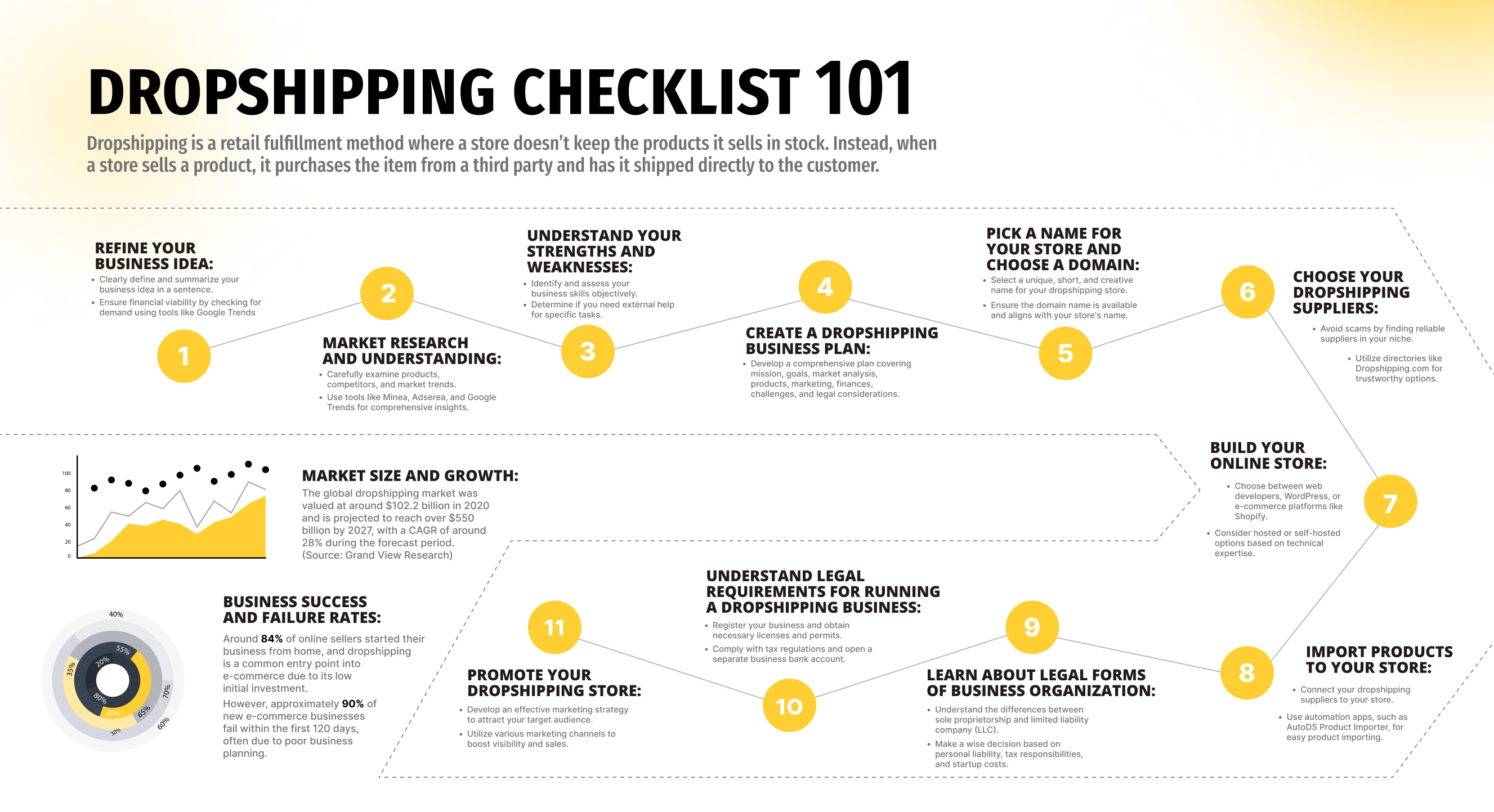
To help you get off to the best possible start, I have made a list of 11 simple dropshipping step-by-step instructions. So, here’s a quick look.
- Refine Your Business Idea:
- Clearly define and summarize your business idea in a sentence.
- Ensure financial viability by checking for demand using tools like Google Trends.
- Market Research and Understanding:
- Carefully examine products, competitors, and market trends.
- Use tools like Minea, Adserea, and Google Trends for comprehensive insights.
- Understand Your Strengths and Weaknesses:
- Identify and assess your business skills objectively.
- Determine if you need external help for specific tasks.
- Create a Dropshipping Business Plan:
- Develop a comprehensive plan covering mission, goals, market analysis, products, marketing, finances, challenges, and legal considerations.
- Pick a Name for Your Store and Choose a Domain:
- Select a unique, short, and creative name for your dropshipping store.
- Ensure the domain name is available and aligns with your store’s name.
- Choose Your Dropshipping Suppliers:
- Avoid scams by finding reliable suppliers in your niche.
- Utilize directories like Dropshipping.com for trustworthy options.
- Build Your Online Store:
- Choose between web developers, WordPress, or e-commerce platforms like Shopify.
- Import Products to Your Store:
- Connect your dropshipping suppliers to your store.
- Use automation apps, such as AutoDS Product Importer, for easy product importing.
- Learn About Legal Forms of Business Organization:
- Understand the differences between sole proprietorship and limited liability company (LLC).
- Make a wise decision based on personal liability, tax responsibilities, and startup costs.
- Understand Legal Requirements for Running a Dropshipping Business:
- Register your business and obtain necessary licenses and permits.
- Comply with tax regulations and open a separate business bank account.
- Promote Your Dropshipping Store:
- Develop an effective marketing strategy to attract your target audience.
- Utilize various marketing channels to boost visibility and sales.
Now, let’s get into this in-depth dropshipping checklist.
What Is Dropshipping?
Dropshipping is a way of selling stuff without keeping it in stock. Instead, when you sell something, you buy it from another company and have them send it directly to the customer.
This means you, as the seller, don’t have to deal with the actual product.
👉 Read about Dropshipping for Students – Starting a Business from College.
How Does Dropshipping Work?
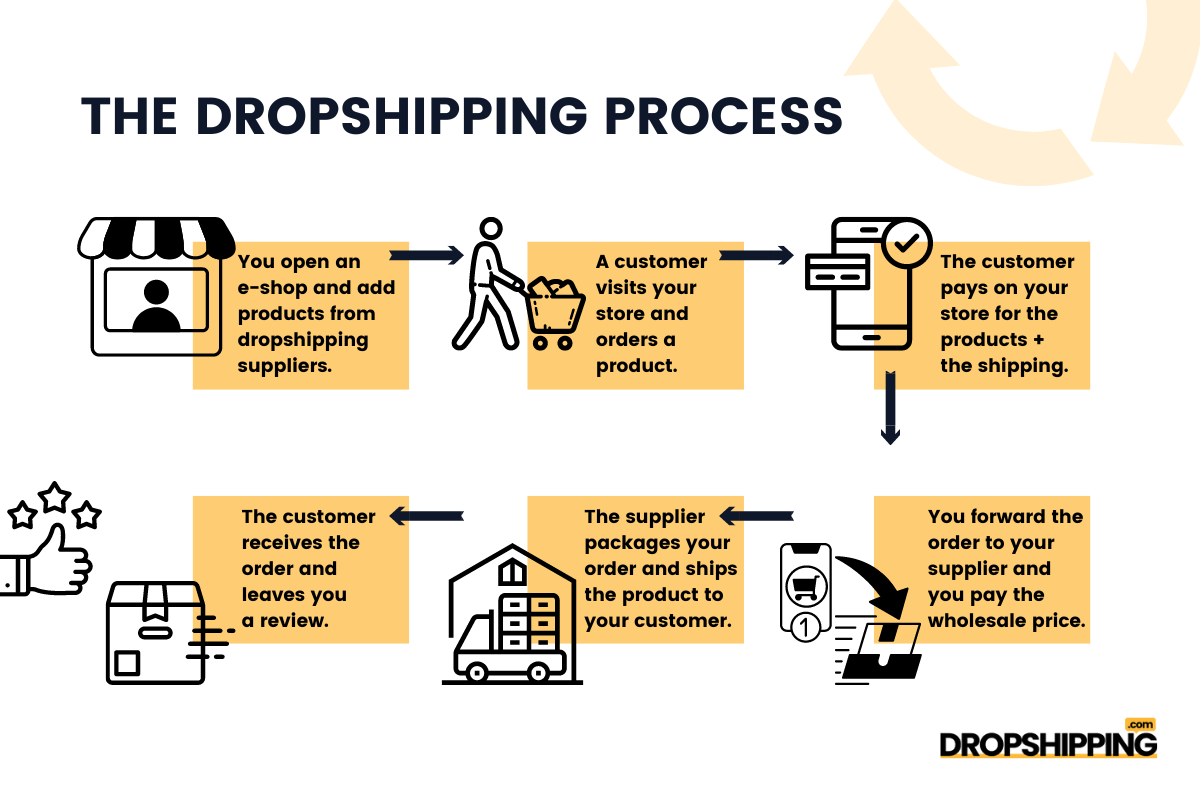
To understand how dropshipping works, let’s break it down:
- First, set up your own online store or list your products on a marketplace.
- Partner with a dropshipping supplier or wholesaler – they handle the shipping for you.
- Choose the products you want to sell from their list and display them on your store.
- When someone buys from your site and pays, send the order details to your supplier.
- Your supplier takes care of the packing and shipping straight to the customer’s doorstep. You don’t have to worry about storing or shipping anything.
- Pay the supplier the wholesale price for the products and keep the difference between that and what your customer paid – that’s your profit.
- If you’ve added your own touch, like branding and packaging, your customers get the products directly from the supplier with your personal flair.
👉 Discover Print On Demand Vs Dropshipping: Which One To Start?
Dropshipping Checklist: 11 Things To Do Before Starting Your Dropshipping Business
Here is my dropshipping step-by-step guide for beginners:
1. Refine Your Business Idea
The first thing in my dropshipping step-by-step guide is refining your business idea.
But what does “refining your business idea” mean? It means that you must get so specific on your idea that you can explain it in only one sentence. You may think I am crazy — your business idea is so much more than that. Let me explain what I mean.
In short, you must organize and visualize all your thoughts before starting your dropshipping business. And once you have done that, get to the very core of your business idea and try to sum it up in a few words.
As you are thinking about setting up a dropshipping business, chances are you already know what you want to sell over the Internet or at least the industry you want to work in.
Once you have refined and redefined your great business idea, you should figure out if it is financially workable. To put it another way, you need to find out if people are willing and want to buy your products.
For example, I personally use Google Trends to check if these dropshipping niches that are on my mind are in demand. Thus, let’s say, I want to dropship art products, or more precisely canvas. So, I will simply type in “canvas” in Google Trends, and track the demand and users’ search queries.

So, for starters, this is a green light for me.
You can continue with carrying out market research and fully understanding the market. You can learn more about it in the next paragraph. So, keep reading!
👉 Check out the 10 General Dropshipping Store Examples To Inspire Yours.
2. Do Market Research And Fully Understand Your Market And Competition
Why is market research the second thing on my dropshipping checklist? Before you start dropshipping, you must understand the market you are getting into.
Thus, it is crucial to carefully examine the products you want to sell, get insights about competitors, and build a solid strategy to win the market. You want profit, right?
So, since I’ve already explained how you can check product demand using Google Trends, I have other advice for you. Well, the fact that people search for a specific product, does not mean they are going to buy it.
Thus, that’s when product research tools, like Minea, or Adserea, come in handy. You can check on each product’s sales, profitability, costs, market prices, and more.
For example, I am personally using the AutoDS product research tool which helps me discover, source, research, and import products with incredible speed.
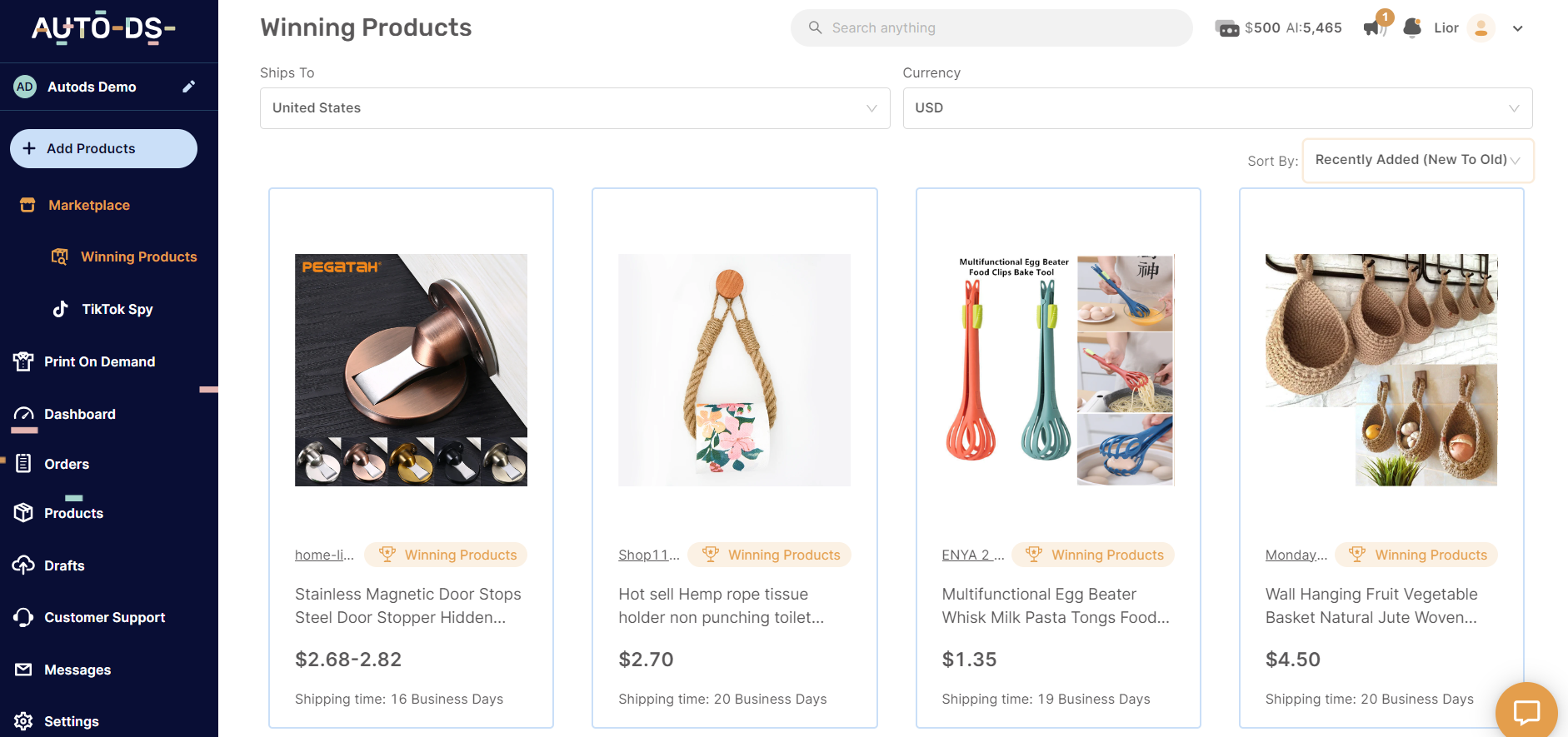
Thus, I can check on popular products to get a comprehensive product overview, supplier list, price, shipping, rating, reviews, and more.
But this is not all you need to do here. You should also fully understand your market and identify and evaluate your competitors.
👉 Check out the 12 Best Shopify Spy Tools To Do Competitor Research.
You have to go wide to fully understand these things. To do that, you should collect and analyze information about your market, including your competitors and customers.
This involves doing your own online research and conducting surveys.
To better understand your customers, you can use tools like Google Trends and SurveyMonkey. For competitive monitoring, you can use the following competitor analysis tools: Alexa, SimilarWeb, and Quick Search.
3. Understand Your Own Strengths and Weaknesses
As a first-time dropshipping entrepreneur, you may be blind to your own weak spots. For this reason, understanding your own strengths and weaknesses is the third thing on our dropshipping checklist.
You must understand your own strengths and weaknesses prior to entering the dropshipping market. To be more specific, simply ask yourself where you want to go as well as how you can get there.
Firstly, make a list of every business skill you think you have, including communication and negotiation, problem-solving, leadership, marketing, financial management, etc.
Secondly, try to be as objective and realistic as possible.
Ultimately, identify whether you can do everything yourself or whether you need to engage a web page designer, lawyer, accountant, or digital marketing specialist. .
4. Create a Dropshipping Business Plan
Creating a dropshipping business plan is the first real step you need to take before you start dropshipping. A business plan is the key to success.
Plus, it can give real and tangible answers to important or even challenging questions.
You cannot build a house by simply walking over to an empty lot and nailing boards together. And the same goes for your startup.
You cannot start a dropshipping business without a dropshipping business plan. So, let me give an example. 👇
Here’s some friendly advice on putting together a solid dropshipping business plan:
Get Straight to the Point:
- Begin with a straightforward executive summary. Sum up your business, mission, and goals in a nutshell.
Paint a Picture of Your Business:
- Give a quick rundown of what your dropshipping business is all about. Explain what you’re selling and your chosen niche.
Know Your Market:
- Dig into who your customers are and check out your competition. Spot trends and opportunities in the market that you can leverage.
Products and Partnerships:
- List out the products you’re excited to sell. Share the lowdown on your dropshipping suppliers and why you’ve chosen them.
Spread the Word:
- Lay out your plan for getting the word out. How will you market your business? Detail your online presence and social media strategy.
Behind-the-Scenes Operations:
- Take a peek behind the curtain. Explain how you’ll handle orders, manage inventory, and maintain a good relationship with your suppliers.
Follow the Money:
- Money matters! Break down your startup costs, pricing strategy, and how you’ll make those profits. Show us the numbers.
Be Prepared for Bumps:
- Talk about potential challenges and how you’ll tackle them. It’s all about being ready for whatever comes your way.
Dot Your Legal I’s:
- Nail down your business structure (like, are you an LLC?). Make sure you’re on the up-and-up with local rules and taxes.
Timeline of Triumph:
- Sketch out a timeline for your big moments. When will you launch, hit certain goals, and make your mark?
Keep an Eye on the Prize:
- Set up some gauges to measure your success. What are your key performance indicators? How will you keep track of your wins?
If you want to learn how to create a business plan for dropshipping, read my article about Dropshipping Business Plan – 13 Tips for Creating Yours.
💡 Tip: Read about Can You Use Upwork for Dropshipping? – Build With Freelancers.
5. Pick a Name For Your Dropshipping Store
Sure, this is the most alluring section of our dropshipping checklist because it enables you to be creative. Yeah, you can be creative while picking a name for your dropshipping store!
The name of your business is actually the first piece of your brand that people will experience.
Therefore, it is essential to find the right name for your dropshipping store to help it stand out from the crowd and establish a unique identity. Hence, your name needs to describe your business.
For example, if you don’t have any ideas, or you are too overwhelmed to come up with one, you can use AI tools like ChatGPT and ask for help. So, simply use a ChatGPT prompt, and you will get ideas.
Let’s try it out.

Well, I got over 20 store name ideas. And, you can always ask for more.
👉 Want to learn how to use ChatGPT for ECommerce? Check out my article about ChatGPT Hacks For Dropshipping: How To Boost Your Business?
Also, here’s an advice. When choosing the name, there are a few things you need to consider:
- Be original and do not copy your competitors.
- Avoid a hard-to-spell name.
- Keep it short and simple.
- Be creative and imaginative.
- Be descriptive but not too vague.
Pick a Domain Name
Furthermore, you should also ensure that the domain name you choose is available for purchase. Plus, the domain name should be identical to or at least closely match the name of your dropshipping store.
But what is a domain name? It is the address of your website that people type into Google to access your website. You can check the availability of your domain name by using tools, like Name and Instant Domain Search, to name a few.
Also, I advise you to use reputable hosting providers and get a secure domain name.
For example, GoDaddy is a company that helps dropshippers and businesses with web hosting and registering domain names. They provide various services for individuals and companies of different sizes.
So, you can use this hosting provider to find and register the domain name you want. Additionally, you can handle multiple domains using just one account.
6. Choose Your Dropshipping Suppliers
The next step of this dropshipping checklist is crucial for me, as I want to avoid dealing with dropshipping scams and losing money.
So, I recommend finding reliable suppliers who create the kind of art you want to sell. Once you find them, make partnerships or agreements to ensure a steady supply of inventory.
For instance, I consistently find useful details in the Dropshipping.com supplier directory. They provide a free directory with over 2000 trustworthy suppliers for you to choose from.
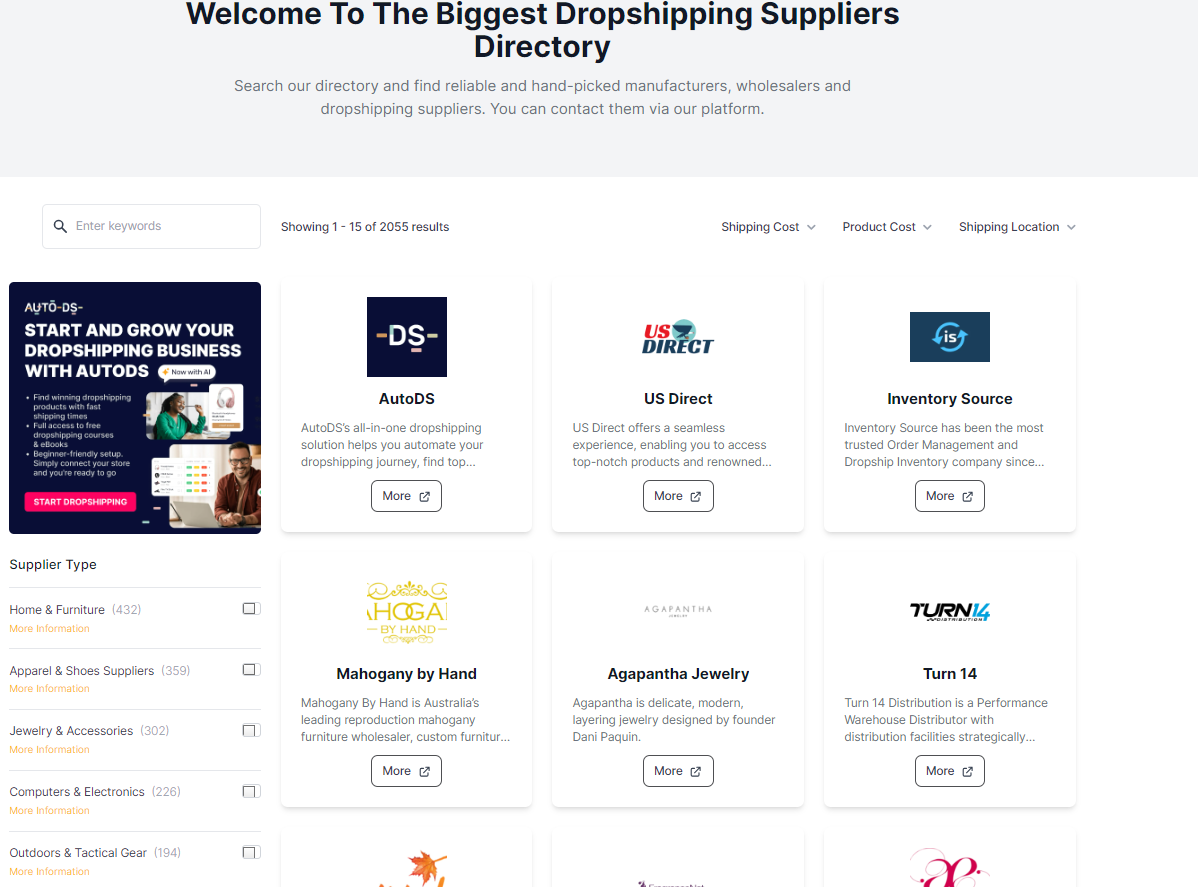
This directory helps me narrow down my search based on my specific dropshipping niche, supplier location, shipping costs, and other criteria.
Additionally, I can access valuable information about each supplier’s pricing, order processing time, minimum order quantity (MOQ), warehouse location, product range, and more.
7. Build Your Online Store
According to our dropshipping step-by-step guide, the next thing you need to do is to build your online store. And, this is probably one of the most important steps on my dropshipping checklist.
But before you start dropshipping and building your own website, we just want to point out that there are different sales channels out there. As a newcomer to the dropshipping industry, you need to know that the main online sales channels for dropshipping include: social media channels, online marketplaces (AliExpress, eBay, Amazon, etc.), and your own website.
You have probably heard of some online marketplaces so far. Also, you probably know that there are numerous online retailers who sell the same products on these marketplaces.
This means that there is a high level of competition there. And this may stop you from standing out from the crowd and establishing your brand.
If you still want to sell on these online marketplaces, then good luck! But now, we will focus on how to build your own e-commerce website and establish your brand.
How to build your own e-commerce website:
There are three main ways to build your own e-commerce website – engaging a web developer; using WordPress, or using an e-commerce website builder/platform.
- Use an Open Source system to build from scratch. If you choose to use WordPress to create your website, you should have certain technical skills and knowledge. Hence, it offers unlimited customization, making it perfect for creating a totally bespoke e-commerce store.
- E-commerce website builders or platforms. On the other hand, e-commerce website builders or platforms are suitable for tech beginners who want to build an e-commerce store fast. Using an e-commerce website builder or platform, like Shopify, BigCommerce, Volusion, WooCommerce, Magento, and Wix, to name a few, is an easy way to create your online store.
- Web developers. If you have never built a website and you really need some professional help with your website and graphics, then hiring a web developer is a good idea. A web developer can build a well-performing e-commerce website from scratch. Just remember that this is definitely the priciest option out there.
Prior to choosing one of these platforms, keep in mind that some of them are hosted, whereas others are self-hosted. For instance, Shopify, BigCommerce, Volusion, and Wix have hosted platforms, whereas Magento and WooCommerce are self-hosted ones.
But what is the difference between these platforms? The main difference between self-hosted and hosted e-commerce platforms is that the hosted ones are more suitable for non-tech people.
But if you are a tech-savvy person, then one of the self-hosted platforms will be the right choice for you because it will give you more freedom.
So, here’s my advice.
I personally use website builders for setting up an online store. It is easy, fast, affordable, and convenient. Plus, you need no coding skills.
Hence, for me, the number 1 choice is Shopify. It has a user-friendly interface and a variety of visually appealing themes for dropshipping stores. 👇
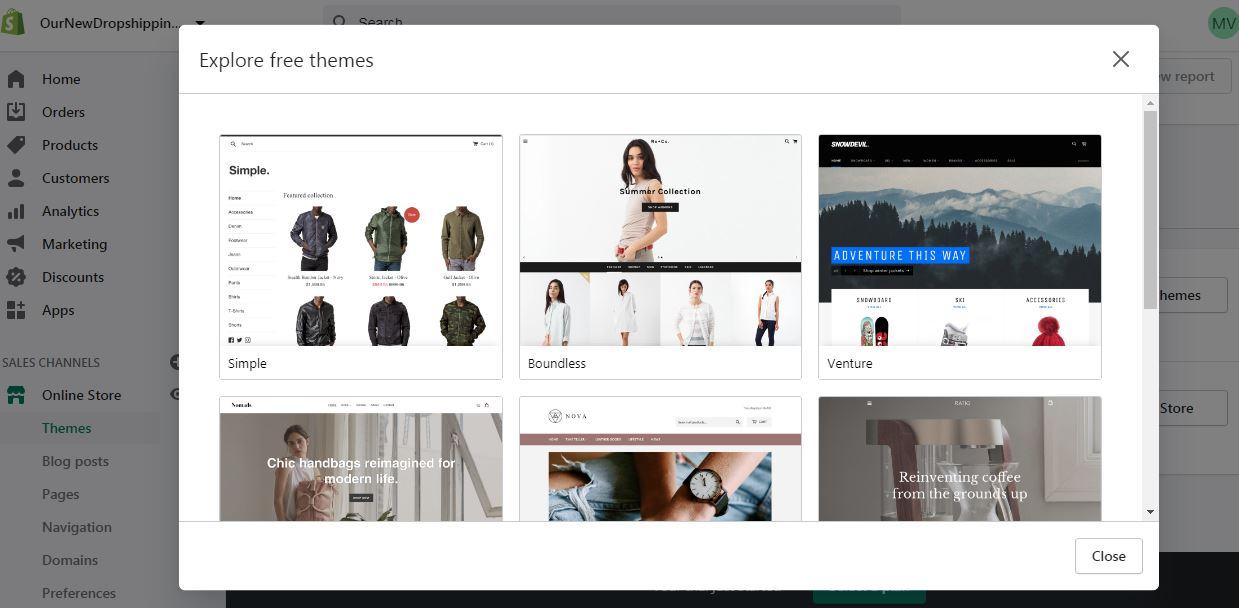
Plus, their drag-and-drop editor allows you to effortlessly create and modify your store.
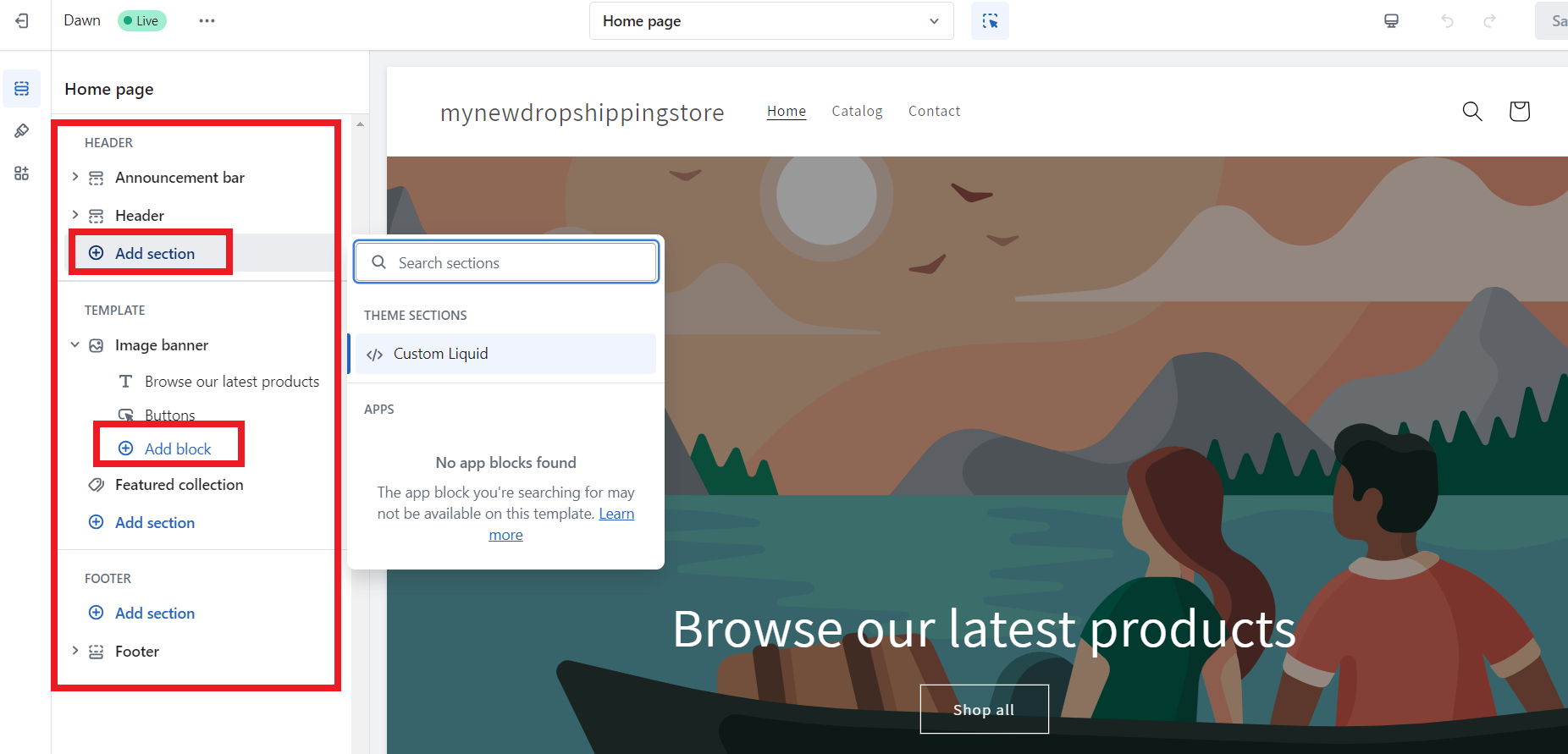
Also, Shopify seamlessly integrates with various dropshipping apps. So, you can make sure your business will be completely automated.
8. Import Products To Your Dropshipping Store
After figuring out your dropshipping suppliers, and built your store, the next thing to do is connect them to your store.
This dropshipping checklist step allows you to begin adding products, creating appealing product descriptions, and making sure your store is easy to find on search engines.
So, I suggest using automation apps to simplify and automate the process of importing and listing products.
As an illustration, I’ve used a few of these apps before. With the AutoDS Product Importer tool, you can easily bring in products to your dropshipping tool by just clicking a few times. This includes single, bulk, and scheduled import options.
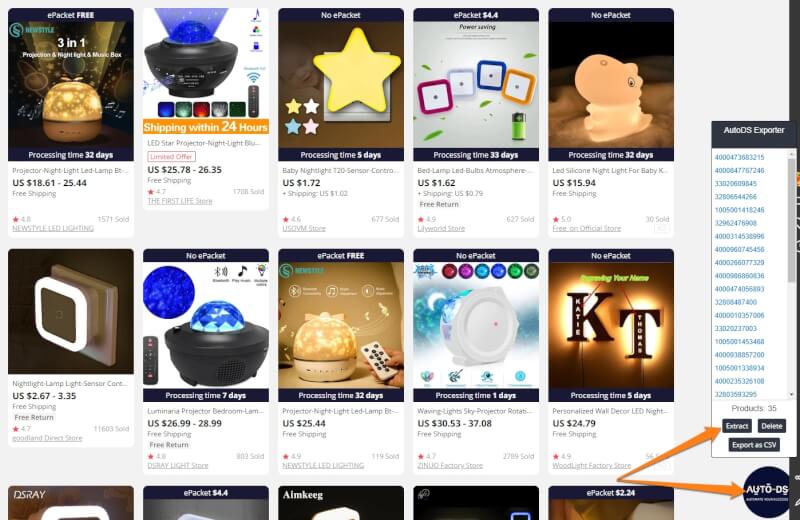
9. Learn More About the Legal Forms of Business Organization & Choose The Right One
Are you interested in setting up a sole proprietorship, a partnership, a limited liability company, etc.? Before launching your dropshipping business, you should learn more about the legal forms of business organization.
So, that is the next step on my dropshipping checklist.
Therefore, I will give you a brief overview of the two most common forms of business organization when it comes to dropshipping – sole proprietorships and limited liability companies.
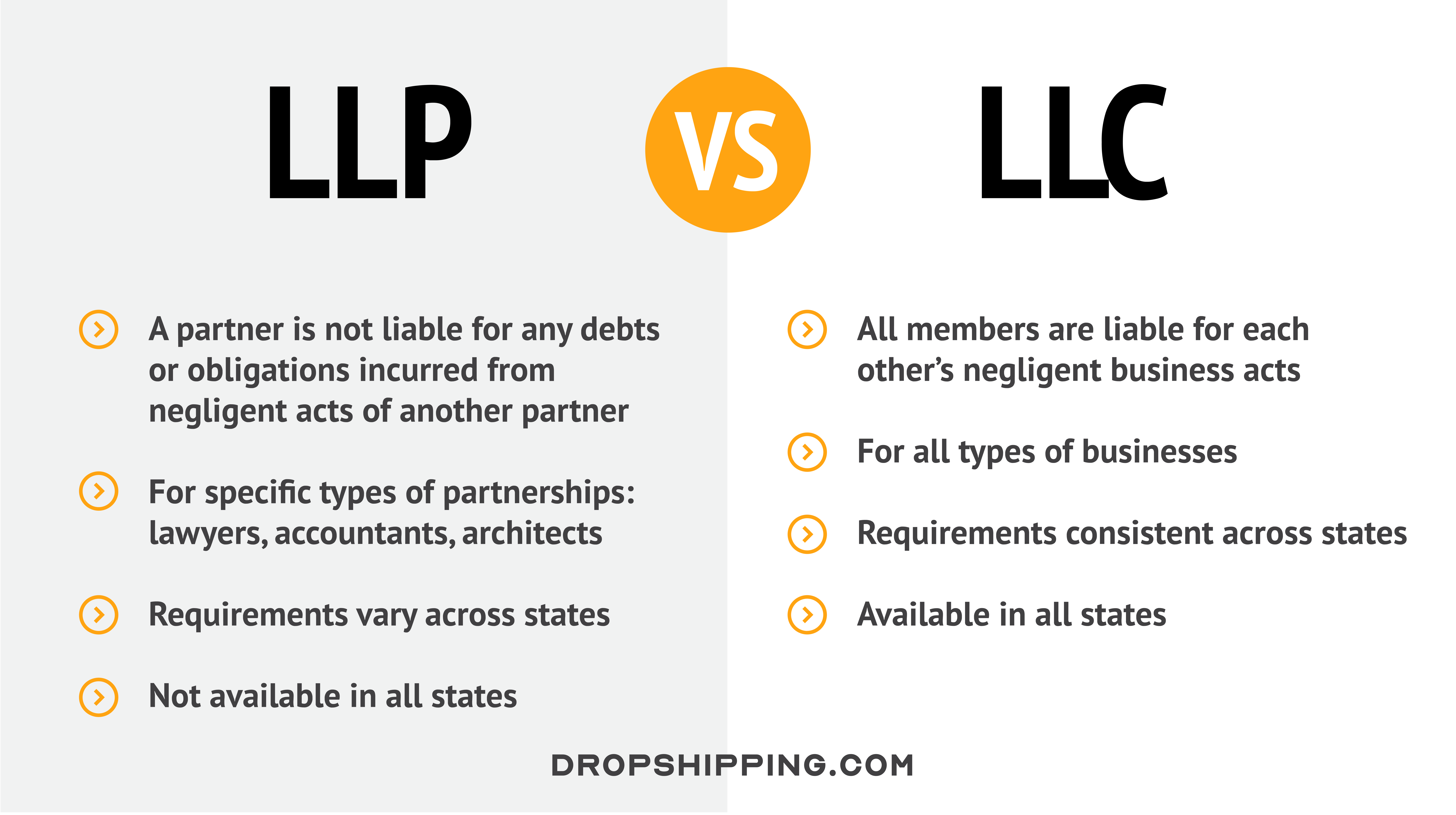
- A sole proprietorship. A sole proprietorship is easy to set up. But it fails to offer personal liability protection. The reason for this is that in a sole proprietorship, there is not any separation between you and your business. Thus, you are personally liable for all debts of your company.
- A limited liability company. A limited liability company is a bit harder to set up and run. But it offers liability protection since there is a separation between you and your business.
As a new drop shipper, the simplest and cheapest option is to start a sole proprietorship. However, a limited liability company is the best option if you want to protect your personal assets.
Take your time and make a wise decision because it will affect your personal liability, tax responsibilities, paperwork requirements, startup costs, etc.
💡 Tip: Read about LLC vs LLP: What’s The Big Difference?
10. Get Familiar with the Legal Requirements For Running A Dropshipping Business
The legal requirements to run a dropshipping business depend on the geographic location of both the customers and the business owner. And, this is another very important step on my dropshipping checklist.
So, you need to understand the legal requirements for business registration and taxation in the country where you are about to do business. If you are planning on selling online in another country, your customers’ country of residence might have specific regulations on the kinds of products that can be imported safely.
Before you start dropshipping, find out if there are any legal requirements you must consider. Failing to comply with the laws, regulations, and guidelines relevant to dropshipping may result in legal punishment like fines.
To avoid any kind of legal punishment and start your online venture the right way, consider the following legal issues:
- Register your business.
- Contact the occupational regulatory agency in your state to find out if your dropshipping business is regulated and you need a business license or permit.
- Contact your state’s taxation office and register for the right taxes (e.g., sales and income tax.)
- Open a business bank account. This prevents you from mixing your business and personal funds together.
This may be a complex issue. Therefore, it is advisable to consult an accountant or a tax lawyer unless you are a legal professional yourself.
💡 Learn everything you need about forming an LLC Dropshipping business.
Also, educate yourself about Dropshipping Taxes and Payments – Guide For Beginners.
11. Promote Your Dropshipping Store
Last but not least on my dropshipping checklist- marketing! Well, sales without marketing do not exist.
So, now that you have sorted everything out, you need to promote your store before you start dropshipping. The way you market your dropshipping business determines if it will be successful or not.
When it comes to dropshipping, marketing is more important than ever. So, make sure you create an effective marketing strategy to attract your target audience and boost sales.
Fortunately, there are dozens of ways you can market your online store. Depending on your budget, you can combine some of the following marketing tactics: content marketing, SEO for dropshipping stores, social media marketing, Google Ads, SMS marketing for dropshipping, industry-specific forums, influencer marketing, and more.
Moreover, I highly recommend you to boost your social media ads, since it is the era of social media! Hence, Facebook ads, Instagram ads, or TikTok ads, they all have ability to reach your specific audience based on demographics, interests, and behavior.

Also, video marketing can really help you showcase your products, describe their features, functionality, benefits, how to use, etc.
Dropshipping Checklist FAQs
1. Is Dropshipping Dead?
No, dropshipping is far from dead. It’s thriving and expected to reach $301.11 billion in 2024. Google Trends and global eCommerce market size statistics confirm its continued growth, proving that the dropshipping business model is very much alive.
2. Can I Get Rich With Dropshipping?
Yes, dropshipping is a low-risk, highly profitable model that can become a full-time income source. Success, however, requires developing skills in areas like copywriting and paid advertising. While getting rich quickly is challenging, it’s possible with patience and the right approach.
👉 Read stories of the Top 11 Richest Dropshipping Store Owners In The World.
3. Can I Start Dropshipping With No Money?
Yes, it’s possible to start with no money initially, using free trials of website builders like Shopify, finding free dropshipping suppliers on platforms like Dropshipping.com or Aliexpress, and advertising for free through SEO strategies. That’s how dropshipping can work with no money.
👉 Discover the Free Dropship Websites: Start Dropshipping With $0.
4. What are some dropshipping product ideas?
Dropshipping offers various product options like clothing, home decor, beauty products, electronics, and sneakers. Product research tools like AutoDS, Adserea, Sell The Trend, or Minea can help identify emerging markets such as eco-friendly products, pet supplies, or fitness equipment.
5. Do I need to register a business entity to dropship?
Yes, it’s generally recommended to register a business entity before starting a dropshipping business. This involves steps like choosing a business name, deciding on a business structure, obtaining an EIN, and complying with regulations. Consulting with a professional is advisable for compliance.
6. What Is The Average Dropshipping Profit Margin?
The average dropshipping profit margin ranges from 15% to 20%, although this may vary based on the dropshipping niche.
7. Is dropshipping legal?
Yes, dropshipping is legal as long as you follow local laws, get the required licenses, and comply with regulations. It involves conducting business without any illegal activities.
8. Can I Start a Dropshipping Business As a Teen?
Absolutely! Teens can start a dropshipping store, but challenges may arise due to the lack of a personal bank account or ID for verification. A workaround is to use a parent’s or older sibling’s bank account for transactions. However, it is advisable to first learn how dropshipping works.
👉 Learn How Old Do You Have To Be To Dropship? A Guide For Age 15, 16, 17, 18.
The bottom line
Follow my simple dropshipping step-by-step guide before starting your dropshipping business. I hope that this easy-to-follow dropshipping checklist can help you create an online business that you can be proud of.
Also, in one of my previous articles, I have provided answers to the question about how to start a dropshipping business. So, as a new dropshipping entrepreneur, please feel free to read the article.













![The Top 21 3PL Companies Compared [2024 List & Guide]](https://images.weserv.nl/?url=https://prod-dropshipping-s3.s3.fr-par.scw.cloud/2024/03/Frame-3922469.jpg&w=420&q=90&output=webp)